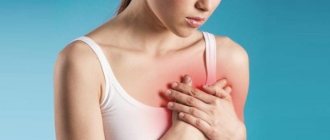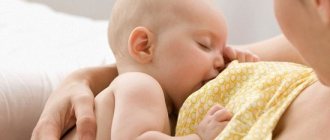Do you remember the very moment when you held your newborn baby in your arms for the first time? Tiny, awkward, still unable to do anything, but already a real person. And in my head I only think about holding, protecting, not damaging this fragile miracle of nature. Hold and not let go, inhale the aroma of the crown, warm with your warmth. It is “in the arms,” and especially in the mother’s arms, that the child receives that close contact that forms his basic trust in the new big world.
But after just a few days of communicating with the baby, the needs of adults come into their own. But adults (and especially mothers) constantly need something: to take care of the child (especially if he is not the only one), about themselves, about other family members, to provide food and maintain everyday life. And it’s good if adult needs and the needs of the baby coexist peacefully. But it happens differently. And in such cases, the loving adults around the child think: is there a means that can free up their hands for business and provide the required contact to the newborn ?
The sling consultants answer: “Yes!” These are correct (physiological) carriers that can hold a baby from the first days of life, repeating the embrace of caring hands, without causing harm.
What is important to know when choosing a carrier? What should you pay attention to? Can you be sure that the most expensive carrier is the safest? Can baby carriers be used with newborn babies or do I have to wait until a certain age? In this article we will try to provide answers to these questions.
Can a baby do without a sling: why do you need a carrier?
First of all, parents need a sling. Moms always have this problem: they need to take the child somewhere. Most often, parents entrust this task to the stroller in which the baby spends most of the time. But sometimes it happens that the child does not want to sit in the stroller at all and the mother is lost: whether to take the baby in her arms, or give it to the grandmother, or leave it as is.
Today there are such super things called slings - helpers in carrying children in their arms. There are a great variety of them: different models, designs, manufacturers. When choosing, you need to start from the age of the child.
Choosing a sling according to the child’s age
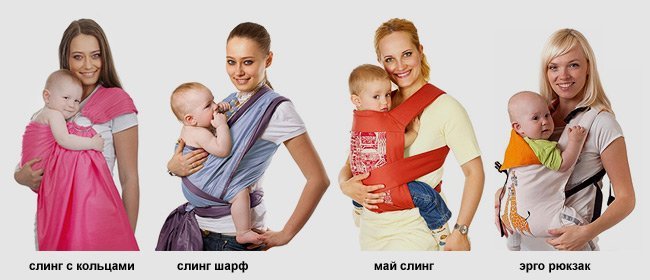
First, we will distribute the types of slings by age, and then we will analyze each in detail:
- Sling with rings – from 0 to 3 months.
- Sling scarf – from birth.
- May-sling, fast-sling - from 3 months.
- Ergo-backpack, sling-backpack - from 5-6 months.
A ring sling and a scarf sling are exactly the two types of slings that can be used from the first days of life. This is due to the fact that only two types of structures involve literally point-by-point adjustment along the child’s spine. It is possible to manually adjust every centimeter: at the top, in the middle, at the bottom, along the hips and shoulder girdle. Starting from 2-3 months, the weight of the child makes itself felt and it is already difficult for the mother to carry the baby on one shoulder.
For baby from 3 months. It is recommended to use a sling or sling scarf. From about 12 months, it is better to use an ergo-backpack, a May-sling or a fast-sling.
The weight of the baby will be evenly distributed between the shoulders, lower back and back thanks to the sling: it will be much easier for the mother. After a year, the child begins to walk: a sling is rarely needed, only when the baby is resting.
How to choose a sling for a newborn?
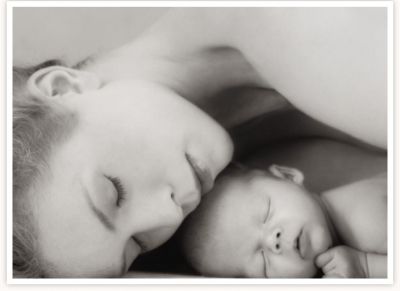
But... Sometimes mom wants to eat :)). Go on a visit or to the store. And in the end, how long can you run circles around the house?! :))
As many mothers say, “a sling gives mom wings!” And this is true - you become more mobile, you can go to the store, visit, cook dinner and do other things.
A small child vitally needs close physical contact with his mother, the feeling of her warmth and smell, so when he is in his mother’s arms, he feels calmer, more relaxed, and shows more interest in the world around him. In the arms of the mother, the child receives that basic feeling of security, warmth and trust, which are so important for the formation of a healthy psyche of the child. However, if the mother needs her hands free (for example, to prepare dinner), then they need to be freed somehow, for example, using a baby-wearing device.
Remember that a child is not a smaller copy of an adult. Therefore, in order to correctly choose a device for wearing a newborn, you need to know the features of his physiology, characteristic specifically for infancy and the first year of life.
Let's take a closer look at this.
Spine
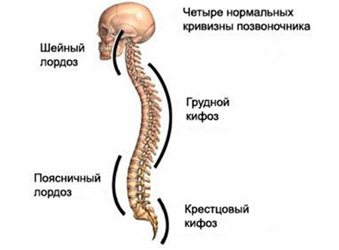
As we have already said, a child is not a smaller copy of an adult, neither from the point of view of his skeleton, nor from the point of view of his functioning. Ossification and complete formation of the spine ends by the age of 25. Until the end of the second month of intrauterine life, the baby’s skeleton consists only of cartilage. As it grows, it will harden and turn into bone. Towards the end of pregnancy, some parts of the skeleton ossify (for example, the femur), and at birth a second wave of ossification begins - at the ends of long bones (bone heads).
Our spine is not perfectly straight. If we look at an adult from the side, we will see four small curves that make the spine resemble the Latin letter S. Thanks to these curves, we have flexibility, we can maintain balance and absorb stress while walking, running and jumping.
However, these spinal curves are not congenital. They form gradually as the child develops physically as a consequence of adaptation to gravity.
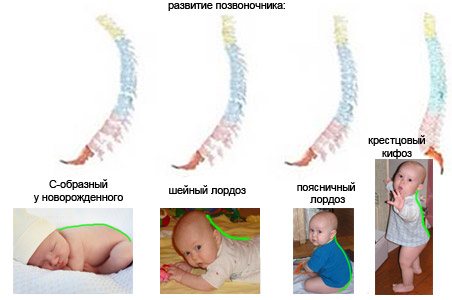
The spine of a newborn baby is bent and resembles a slight arch or the letter “C” . He doesn't have any bends yet and doesn't have enough strength to hold his head up. When carrying a baby in her arms, the mother performs this function for him: she supports his back and head. If we want to carry the baby in some kind of device, it should allow the baby’s head to be fixed at the same level with the body or allow the mother to support it with one hand. From about 6 weeks, the baby begins to raise his head from a lying position and by 2.5-3 months he can confidently hold it in an upright position.
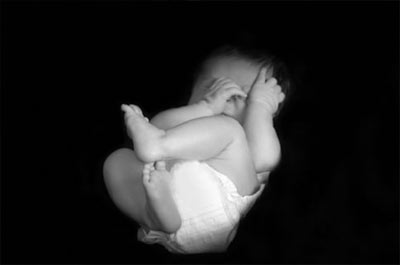
The newborn does not straighten up on its own ; it can only be straightened out by force, for example, if you swaddle it with a “soldier.” If a child is placed on his back, he will reflexively pull his fists to his chest, and he sleeps with his legs spread wide apart in the “frog pose.” The fetal position is the most natural position for babies; it calms and helps baby adapt to the new world.
The vertical and horizontal position of the baby “belly to stomach” in the fetal position is very comfortable for the baby. In this position, children digest food better, thermoregulation is more effective, because the stomach area is closed. On our back, our subcutaneous fat layer is thicker, and our thermoregulatory cells are stronger.
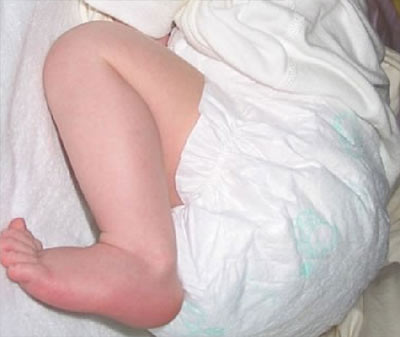
When a child is picked up, his legs remain instinctively bent and spread. Together with the grasping reflex, this position helps the baby cling to its mother. In this way, we provide him with a natural posture that his body instinctively adopts to provide comfort, warmth and security.
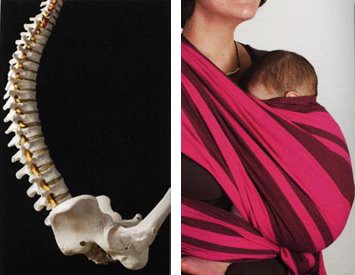
When choosing a device for carrying a baby, it is important to choose something that will allow you to maintain the position of the spine in its naturally rounded form, while well supporting and pressing the baby to the mother, maintaining the “embryo” or “frog” position.
IT IS FORBIDDEN:
All kinds of kangaroos and pseudo-slings on “boards” are not physiological devices for carrying children, because they do not allow supporting the baby’s back in its natural slightly bent state, either in a vertical or horizontal position.
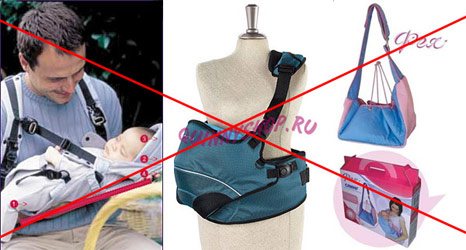
Please note that the arched position of the child's spine does not mean that the entire child is arched! The baby's head should continue the line of the spine, without pressing the chin to the chest. This position makes it difficult for the baby to breathe. This is often facilitated by the design of pseudoslings: they do not have the ability to adequately regulate the tension of the fabric and have the appearance of a bag. The lacing that comes with such a bag only makes matters worse - it presses the baby’s chin even more against the chest and blocks the flow of fresh air.

CAN:
Physiological devices include woven slings: ring slings, scarf slings, May-slings and physiological backpacks. However, not all of them are equally good for newborns.
The most optimal devices for carrying a baby and newborn include a sling scarf and a sling with rings. Both the ring sling and the scarf sling allow you to carry your baby both horizontally and vertically, while providing even support to the baby’s entire body. Uniform tension of the fabric and the possibility of literally fine adjustment of the fabric allows you to keep the child’s spine in its natural position.
The most optimal fabrics for slings are double diagonal and jacquard weave fabrics. They are often called scarf ones, because they are mainly used to make sling scarves. Such fabrics are not sold in regular stores; they are produced specifically for wearing children. They are completely natural: most often it is 100% cotton, sometimes with additives in the form of linen, silk, bamboo, wool and cashmere for cool weather, etc. Like regular fabrics, scarf fabrics do not stretch either along or across: this provides stable support position of the child. But they stretch slightly diagonally: this ensures a comfortable distribution of the load, a special “cuddle” - the fabric is slightly tightened exactly where it is needed, gently and carefully hugging the body of mother and baby.
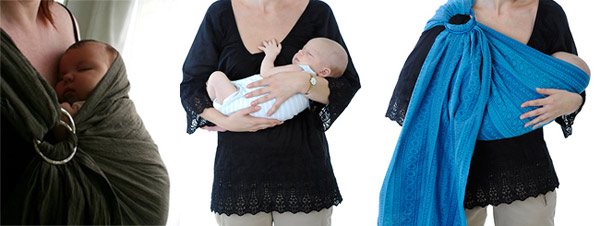
Slings with rings come in both scarf fabrics and regular fabrics: calico and linen. The latter are less flexible than scarf ones and require more effort when adjusting. Ring slings can be worn both vertically and horizontally. In both cases, the sling allows you to preserve the natural arch of the baby's spine and support the head. After a little training, the child’s position can be easily changed on the go.
You can feed your baby both horizontally and vertically, but while the baby is not holding his head up, it is easier to do this in a lying position. Attention! In order for the baby to maintain a correct grip on the breast, his neck must be supported by the bend of his elbow during feeding - this is true for any type of carrier!
A special feature of a sling with rings is the asymmetrical distribution of the load on the carrier (one shoulder and back), so the shoulders must be regularly alternated. This is important not only for the mother, but also for the uniform development of the child’s muscle corset.
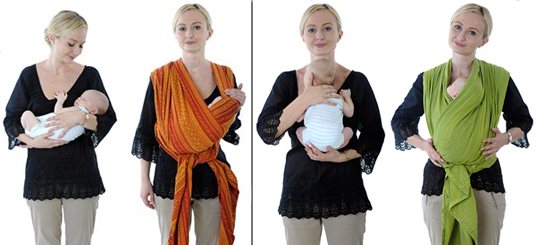
Sling scarf is perhaps the most versatile and optimal sling for wearing both a newborn and an older child. It allows you to carry your baby in horizontal and vertical positions from the first days of life. The baby is in the sling in the same position as in the mother's arms. For wearing newborns, it is preferable to use diagonally weaved fabrics: due to the characteristics of their weaving, these fabrics provide the best fit, the most uniform attraction, the possibility of point adjustment, and support for all parts of the baby’s spine, his head and neck.
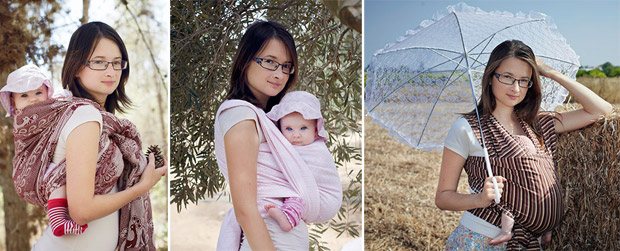
Even a newborn baby’s legs are not hidden inside the wrapping, since in this case he can reflexively lean on them, and this is still harmful for his joints. During the period when the congenital tone forces the baby to tighten his legs, he should be provided with a position in the sling as close as possible to the intrauterine one. To make it possible to conveniently position its legs, single-layer windings (“kangaroo”, “cross over pocket” with unstraightened fabrics) and thin plastic scarves are used. As congenital tone progresses, usually this happens at 1-1.5 months, you can expand the set of windings used and begin to use denser and wider scarves, as they better protect the mother’s back with a fast-growing baby. You can also feed your baby horizontally or vertically.
Sometimes knitted scarves are used to wear newborns: they have a right to exist, but still, in our opinion, a woven scarf provides more adequate support for the baby’s back and a much more comfortable distribution of the load on the mother. After the child reaches a weight of 6-7 kg, it is not recommended to wear knitted scarves: they are pulled back under the baby’s weight, creating excessive stress on the mother’s back and do not provide adequate support to the child’s spine.
May-sling.
If the parent's choice is a may-sling, then for carrying newborns and children who cannot sit independently, it is better to purchase a scarf-may (may-sling made of scarf fabric) or a may-sling made of natural soft fabric - they are more plastic, and therefore better adapt to the physiological characteristics of the baby, this is especially important when carried vertically.
A May Sling is good to have in addition to any sling, such as a ring sling. It is very comfortable to carry your baby vertically with his legs facing out. Thanks to the soft plastic fabric, the scarf allows you to adjust the height and width of the backrest specifically for your child, spreading the legs to a comfortable distance.
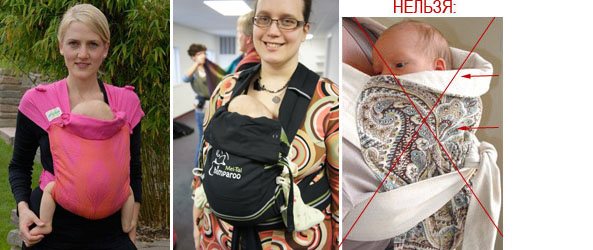
However, not all slings provide uniform support for the baby's back and neck. Pay attention to the right photo: the top of the baby’s spine is not taut at all due to the rigid, non-plastic fabric of the sling. You cannot carry a newborn or infant in a sling if it does not have the ability to evenly support the child’s body. All kinds of tourniquets and knots on the baby’s back are also very undesirable, due to the fact that they create point pressure on the spine. The straps of the baby sling should be straightened, crossed over the baby's back and brought back to the mother's back, where they can be tied.
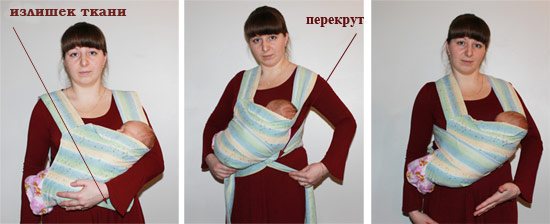
The horizontal position in the May-sling is not very comfortable due to the peculiarities of its design: there is a danger of the baby being slightly skewed along the line of the spine. The excess tissue remaining when the baby is placed in a supine position in a sling creates the preconditions for this. It can be reduced by twisting the straps (see photo), but the twist should not create point pressure on the baby’s back. If you are sure that you are positioning your baby correctly in the cradle, you can use it.
Physiological backpack.
Many manufacturers now recommend a physiological backpack for wearing by newborns or children from 2 months of age. How justified are these recommendations and are they worth following?
Most often, the backpack does not provide a horizontal position, which is so important for a baby. And backpacks with a mattress insert (for example, Ergo), although they make it possible to position the baby correctly, look very cumbersome. Due to the presence of a voluminous mattress insert, both mother and child may be too hot, since its thickness is similar to a flannelette blanket.
Carrying infants vertically in backpacks is not recommended. Whatever the type of backpack, it does not have as many adjustment options (and therefore provide even support for the child) as a woven sling. The backpack has only one adjustment option - straps sewn into the middle of the back. At the same time, the tightest possible attraction of the slings guarantees you only one thing: the middle of the baby’s back will be pressed tightly. But the lower and upper spine may not have the necessary support, as often happens even in backpacks that are “positioned” from birth.
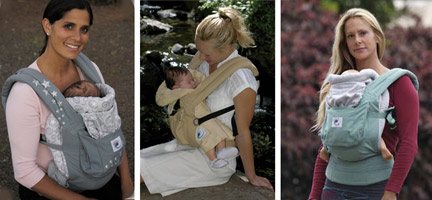
In order to reduce the excess volume of the backpack and pull the baby tightly over the entire surface of the back, many manufacturers recommend adding a diaper: they say, this will reduce the volume. This really allows you to remove excess volume and pull the baby in more tightly, but!! After all, it is important for us not just to flatten the child to the mother, but to position him correctly, maintaining the natural curve of the spine. Often, excessive tightening of the slings in an attempt to achieve a tight pull produces a “caterpillar” effect - the child’s lumbar spine bends like that of a child who can sit independently. Of course, before the moment of sitting independently, it is under no circumstances possible to “artificially” form a lumbar deflection by tightening the slings. See here for more details.
Foreign babywearing schools do not recommend the use of backpacks until children are sitting independently and inserting newborns into backpacks is not considered physiological!
Another important feature of newborns is the immature hip joint.
The hip joint (HJ) is one of the largest joints in humans. It is formed by the acetabulum of the pelvic bone and the head of the femur. Along the edge of the acetabulum there is cartilaginous tissue that increases the area of the joint. The joint is covered by muscles on all sides.
The articular cavity of the child’s TB joint is flattened, it is located more vertically in comparison with the “adult joint”, and the ligaments of the joint are overly elastic. If the development of the joint is impaired (dysplasia), the excessively elastic ligaments and articular capsule are not able to hold the head of the femur in the articular cavity; it moves upward and outward. With certain movements, the femoral head can move beyond the acetabulum. This condition of the joint is called “subluxation”. When hip dysplasia is severe, the head of the femur extends completely beyond the acetabulum, a condition called hip dislocation.

The angle at which the femoral head is inserted into the acetabulum is very important. If you draw a line through the edges of the acetabulum (AB) and a line through the middle of the head and neck of the femur (CF), then the CF line should pass through the middle (point O) of the AB line. The angle formed by these lines should approach a straight line (90 degrees): this ensures an even load on the head and acetabulum and the normal development of these structures.

As noted by Novosibirsk professor Yakov Leontievich Tsivyan, one of the first in Russia to deal with the problem of diseases of the hip joints, “when the hips are abducted, the femoral head is centered in the acetabulum. Thanks to the early and constant centralization of the femoral head into the underdeveloped acetabulum, the latter, under the influence of such centration, begins to develop correctly, and ultimately the former underdevelopment of the acetabulum is eliminated. Consequently, the conditions for the occurrence of dislocation disappear. And by the time the child stands on his own legs, a dislocation cannot occur—the conditions for its occurrence have been eliminated.”
A direct connection has been noted between the increased incidence and the tradition of tightly swaddling the baby's straightened legs. Among peoples who carry children in carriers with straightened legs (Indians of North America and Canada), there is an increased number of cases of hip dysplasia. But in those countries where newborns are not swaddled, their freedom of movement is not limited, and children are carried vertically with their legs apart, the incidence is much lower. For example, in Japan, as part of a national project in 1975, the national tradition of tightly swaddling the straightened legs of infants was changed. Result: reduction in congenital hip dislocation from 1.1 - 3.5 to 0.2% (Yamamuro T, Ishida K. Recent advances in the prevention, early diagnosis, and treatment of congenital dislocation of the hip in Japan. J. Clinical orthopedics and related research 1984 Apr;(184):34-40).
To treat dysplasia, various orthopedic devices are used to keep the baby’s legs apart. All of them are designed to hold the child’s legs in the spread position. In children of the first 2-3 months, if hip dysplasia is suspected, therapeutic and preventive measures are used - spreading the legs with the help of soft pads (wide swaddling, Freik's pillow, etc.), gymnastics using abductor-circular movements in the joint, massage of the gluteal muscles.
Carrying in a sling with legs apart allows you to place the child’s hip joints in a physiological position, while the child takes a position where the knees are higher than the butt. This position (fetal position) can also be used during the period when the baby’s innate body tone is in effect.
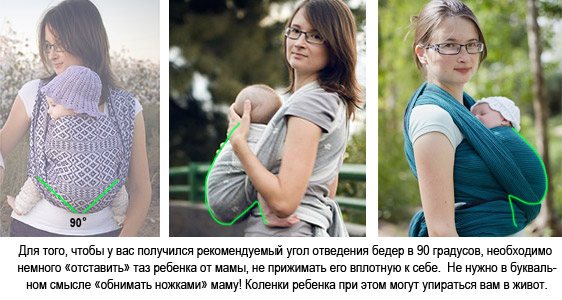
From the moment the tone disappears, it is better to carry the child with his legs outward to avoid unwanted pressure on the feet and legs.
Remember that babies' joints are cartilaginous and very flexible. If the regular and long-term position of the child’s legs does not imply the correct insertion of the femur, then the cartilage may develop poorly.
What does it mean? This means that if you often and regularly carry your baby, for example, in a “kangaroo”, where the baby’s legs simply hang and there is no talk of any physiological separation of the legs at all, then you create the preconditions for problems with the formation of a TB joint in the child. The child in the kangaroo hangs from the crotch, the legs dangle, and a very large load is placed on the lower parts of the immature spine. Frequent wearing in a baby carrier can lead to flattening of the intervertebral spaces and to problems with the spine in the future.
When carrying a child for a long time and/or regularly, it is necessary to provide him with a physiological position of the legs so that the head of the femur is inserted into the acetabulum at a physiologically determined angle.
When carrying a baby in a sling, the hip is always involved in supporting the baby. The main point of load falls on the baby's popliteal area, thereby removing it from the pelvic area. The TB joint is in a physiological position.

However, here it is important not to overdo it. The sling or backpack should allow the child to be spread at a comfortable distance, without allowing the legs to spread excessively. In the “frog” position, the child’s legs should not hug the mother’s waist - there is a certain recommended angle of knee abduction. In newborns it is 60-70 degrees.
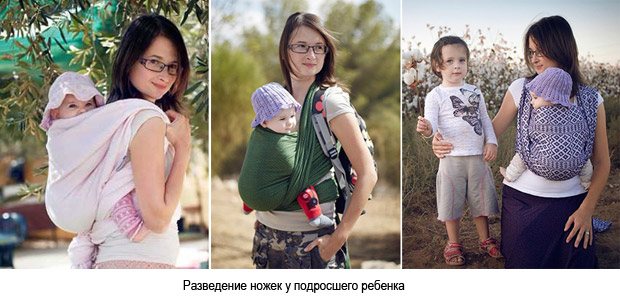
When the tone passes, the angle of hip extension gradually increases to 90 degrees. In order to comply with this requirement, the sling or backpack must meet the physical development parameters of your particular child.
This is how you can't wear it:

The back of the backpack pushes the legs apart, as a result we get overextension of the legs and an incorrect angle of insertion of the femur. The child’s legs are almost spread out into a “split” - i.e. by 180 degrees. With a correct fit, the edge of the back should fall on the popliteal area, and the fabric on the butt and hips should fit tightly so that there is no excess fabric or folds. If the back is too wide, the baby’s butt will not be able to sink to the required depth in the pocket, and we will not get the classic fit in a sling - the M-position. The same effect occurs when worn vertically in baby slings made of hard fabric: if the baby is still small and the fabric is not soft and flexible, it will not fit well and may unnecessarily spread out the baby’s legs.
Everything is easier with slings :). A sling with rings, a sling-scarf and a sling-sling (made of soft plastic fabric) allows you to adjust the width of the backrest specifically for your child. If you want to carry a child in a backpack, it is important that the length of his legs allows him to cover the entire width of the back of the backpack, his butt has a certain volume and weight and allows him to completely fill the space inside the backpack - and for this you need to grow up.
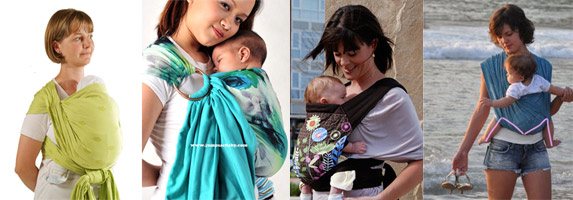
A sling with rings and a sling scarf allows you to adjust the separation of the hips to a comfortable distance for the child, corresponding to his age, while the basic principle of the correct position - “knees above the butt” - is also respected.
Remember: the sling adapts to the child, the backpack adapts the child to itself. If a sling is plasticine from which you can mold anything, then a backpack is a rigid mold into which the child either fits or not.
Let's summarize. Conclusions.
From the point of view of matching the age characteristics of the child, the best sling for a newborn and baby would be a scarf sling or a sling with rings.
They provide excellent support to the child's entire body in both vertical and horizontal positions. A sling scarf will be more versatile and convenient - it comfortably distributes the load on the carrier, allows for uniform adjustment and will provide a physiological position for the child at any age. For older children, it will give more freedom to move their arms - many babies like to sit in a sling with their arms outward, grab their mother’s hair, nose, and, best of all, the beads that mother wisely put around her neck :). If the baby falls asleep, you can hide the baby's arms in the sling. A sling with rings also has these advantages, but loses in terms of comfort for the mother: the load is distributed asymmetrically, the shoulders need to be regularly alternated, and accordingly it is somewhat heavier to wear than in a scarf.
A less desirable, but possible option for wearing may be a sling (made of plastic fabric). Be sure to make sure that the baby sling you choose can provide even support to your baby’s entire spine and neck, and is also easily adjustable in width.
Physiological (=ergonomic) backpacks (including those positioned as “backpacks from birth”) are not recommended for wearing by newborns and infants (at least up to 4-5 months) . Due to the lack of wide adjustment possibilities due to its design, it cannot provide the required support for the child in accordance with his age characteristics.
What else should you pay attention to when choosing a baby-wearing device? Answer yourself the question, in what situations do you plan to carry the child, for how long, how much, how often?
If you need a sling for short-term wear (around the house, to the store, to the car), you can easily get by with a sling with rings. It is mobile, quickly removed and put on, it is easy to change the position from vertical to horizontal, and you can quietly put down a sleeping baby. And remember that asymmetrical distribution of the load on mother’s back does not contribute to long-term wearing.
If you have a very tame baby, you like to take long walks, you like to be mobile, go to the other end of the city to visit :))), and also if you have some back problems (scoliosis, for example), you better choose a sling scarf . It takes a little longer to wind, but it will more than pay for the extra minute of your expenses with subsequent comfort. This is the most ideal sling in terms of load distribution: it fits very comfortably on the shoulders and back, and also allows you to remove some of the load on the waist and hips, often giving an accompanying weight loss effect :).
May-sling is quite easy to use, quickly put on and comfortable to wear, but as you remember, not every May-sling is suitable for a newborn. The May Sling also distributes the load symmetrically: on two shoulders and on the back.
A backpack is one of the most mobile options; it distributes the load symmetrically, but the baby must grow into it. Read more about backpacks here.
Well, now you have the knowledge, based on which you can choose what is right for you!

When writing this article, the following text and photo sources were used:
Recommendations from ClauWi School, Germany Research Dr. Shelberger, Germany Shaposhnikov Yu. G. (ed.) Traumatology and orthopedics. Guide for doctors. t3, 1997 https://wrap-carries.livejournal.com/ “Porter mon bébé”, authors Cécile Cortet and Céline Guerrand-Frénais Babywearing Safely and Securely Elizabeth Antunovic “Slings, strollers and stress. What is better: horizontal or vertical position during the newborn period? Yakov Leontievich Tsivyan, book “Specialty – Surgeon”. We express our great gratitude for the photographs to Ira Aviv, Israel, as well as to the site https://www.ellevill.org/
Author - Alla Kornilova, sling consultant
Sling with rings for newborn
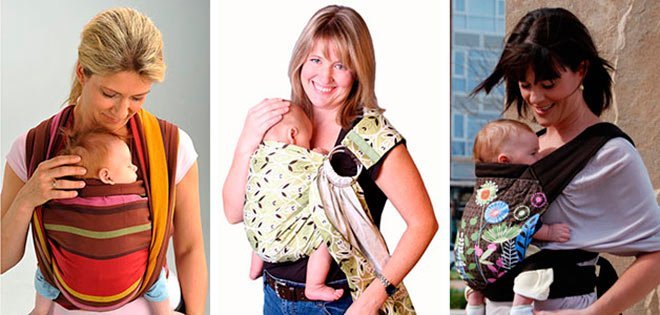
It is a piece of fabric, at one end of which metal or plastic rings are sewn into the fabric. The second side of the fabric is fixed in the rings. Worn on the shoulder. For carrying, the “cradle” position is usually used.
The ring sling is easy to use, just right for mothers with newborns. He transfers the entire load of the baby onto one shoulder, so the position needs to be alternated periodically: we go for a walk on one shoulder, and back from a walk on the other; or carry the baby on one shoulder for the first half of the day, and on the other for the second half of the day. Choose exactly how to alternate it, but you must do it. This is important not only for you, but also for the correct formation of the muscle corset of the baby’s back.
Design advantages:
- Allows you to adjust your child's position on the go.
- During use, it is easy to take the baby out and put it back.
- You can move the baby to the crib without waking him.
The load on one shoulder of the mother is a disadvantage of this carrier.
When choosing a sling with rings, pay close attention to the rings - this is a very important part of the design. Check the strength of the rings with your hands for bending and stretching.
The rings should be large: metal - about 8 cm, plastic - about 10 cm in diameter.
Sling scarf for newborn

It is a piece of fabric measuring up to 0.7x6 meters. This type of carrying assumes a symmetrical position. There is no need to alternate shoulders here; you can use all the basic windings. The load is distributed evenly across the shoulders, back, and hips.
Knitted slings-scarves
For the smallest children, you need to use knitted slings-scarves, because they stretch, unlike woven ones, which do not stretch either in width or in length. Knitted slings are created not on looms, but on knitting machines. They are intended for newborns and premature babies.
The older the baby gets, the heavier it becomes. The heavier the child, the more the knitted fabric stretches, sagging under the weight of the baby.
A knitted sling involves a winding called a “cross under a pocket”: the carrier is put on the mother completely tightly and the baby is placed in the finished winding. If we need to get the baby out, we take him out, the sling remains on the mother, there is no need to rewind.
In summer it is hot in a knitted sling, because it is stuffy. Woven fabric allows air to pass through much better.
May-sling and fast-sling

This is a fast and easy to learn sling. Typically, a May Sling is used from 3-4 months, but some designs are suitable for children from birth. Summer has arrived, it has become hot, and you realize that the scarf sling has thick, warm fabric. When it is already 20-25 degrees outside, it is recommended to use a thin and light May-sling: it will be ventilated and not at all hot in it.
My-sling is structurally different from a scarf-sling: it is more rigid, and the child already feels differently in it.
The baby may have an adaptation period: he will cry or break out. But gradually both mother and child get used to it, receiving only pleasure from using it. The fabric of May- and Fast-slings is very durable; they are designed to bear quite a lot of weight.
Other options
In addition to the options listed, there are also fast slings. They are similar to backpacks, only with wider and shorter shoulder straps that can only be worn crosswise.
Hipsit is a device in the form of a wide belt with a seat attached to it for a child. Can only be used to be worn on the side. The baby must learn to sit confidently before placing him in the hipsit. It is better to support the baby with one hand, even if there is a special supporting back in the device.
Is it possible to use an ergo-backpack and a sling backpack?
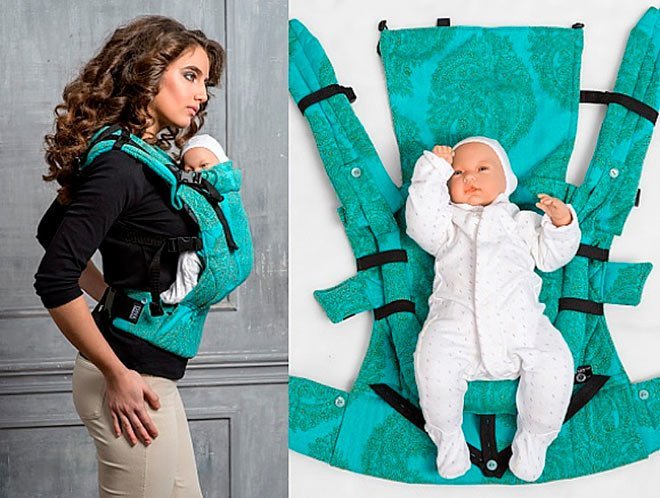
A classic ergo backpack is a wide, rigid belt with a back and straps. A backpack is the same as a sling, and the rules of a sling must be followed: the correct position of the child’s legs and a tight pull towards the mother removes the load from the spine. You can pull the baby towards you with adjusting tapes, which create quite high pressure for a newborn.
If your child does not yet sit independently, then using an ergo-backpack is not recommended.
Each ergonomic backpack has a specific back pattern, which is shaped like a smile: this shape is supposed to match the baby’s bottom. Naturally, everyone's bottom is different, and the shape may not suit your child specifically. Therefore, before buying, you need to try on different sling backpacks and choose the one that suits your baby.
The backpack pattern has all kinds of inserts, seams, zippers, and pockets. That is, it is not just a layer of fabric that is evenly stretched, but a structure made of material, seams, zippers, zippers, and a hood in a pocket, which a priori creates an uneven load on the child’s spine. No matter what marketing slogans manufacturers come up with, you should not use an ergo-backpack for newborns. Be a conscious parent.
In what position to carry babies
The purpose of the sling is to provide a comfortable, physiologically correct position for the baby in the mother’s arms. Therefore, it is recommended to carry the newborn in front, facing the woman’s body. It is important to pay attention that his posture is natural. This is an arched back, spread legs, lowered pelvis.
For the proper development of the baby's hip joints, it is important that the knees are higher than the butt. From behind, his posture should repeat the letter “m”. There is no need to force him to hug his mother with his legs; his knees can rest against his stomach. Therefore, it can be moved a little away from the body.
Immediately after birth, when natural muscle tone is present, the legs can be hidden in a sling. After the tone disappears, you need to carry the baby with his legs facing outward. In this case, the edges of the carrier should rest against the area under the knees and support them. The fabric of the sling should fit snugly around your butt and hips without creating folds.
Experts do not recommend carrying a child in the kangaroo backpacks familiar to many. In them, the legs hang down, and it turns out that he is sitting, leaning on the crotch area. Therefore, such carriers are not recommended at any age.

With the baby's legs facing outward, facing the woman's body

Hide your legs in a sling




